Arm fat can easily accumulate when more calories are consumed than burned, and if the arm muscles aren’t regularly exercised. Aside from consuming and avoiding certain foods, losing arm fat is a team effort, requiring multiple lifestyle habits, such as staying adequately hydrated, getting enough sleep, and managing stress.
This article will explain how to lose arm fat in 2 weeks with detailed suggestions for dietary shifts, sleeping regimes, and exercises that aid in fat loss and target the arms, specifically. You’ll walk away with specific examples of cardio and strength training exercises to do, types of foods to incorporate, and methods for stress reduction to try, all of which can help reduce arm fat.
How To Lose Your Arm Fat In 2 Weeks?
A regimented approach to healthy diet and exercises, along with proper sleep and hydration, is the winning combination to help you lose your arm fat in 2 weeks. Lose arm fat quickly by:
- Doing strength training.
- Doing cardio.
- Eating more protein.
- Reducing carbs.
- Eating fiber.
- Drinking enough water.
- Getting enough rest.
- Reducing stress.
How To Lose Arm Fat In 2 Weeks?
Follow these regimented steps to see a noticeable difference in arm fat in two weeks. These steps factor in dietary, exercise, and lifestyle modifications that, together, can help you achieve optimal results.
Do Strength Training 3 Times A Week
If you want to know how to reduce arm fat quickly, the secret is in strength training.[1] Targeting the arms with strength training exercises, such as push-ups, tricep presses, and lateral arm raises, is key for losing fat without losing muscle. In fact, weight lifting not only burns arm fat, but can increase muscle, and is an ideal way to get bigger arms.
Strength training provides metabolic benefits beyond losing arm fat, making it a key player in overall health. Do strength training at least three times per week. On days when you are not doing strength training, choose cardio exercises to keep the fat-burning momentum going.
Do 75-150 Minutes Of Cardio Each Week
Another way to lose arm fat is to engage in cardio every week. Aim for between 75 and 150 minutes per week. Cardio, also referred to as aerobic exercise,[2] is any exercise that increases heart rate. Cardio can be high intensity, such as running fast, or low intensity, such as riding a bike slowly.
Swimming, dancing, walking, and even housework are all forms of cardio, and each has its own benefits for fat loss, as well as the flexibility to be done at high intensity or low intensity. There are pros and cons of jumping rope vs. running, for example, but one may be more appealing to you than another based on your personal goals.
Eat More Protein
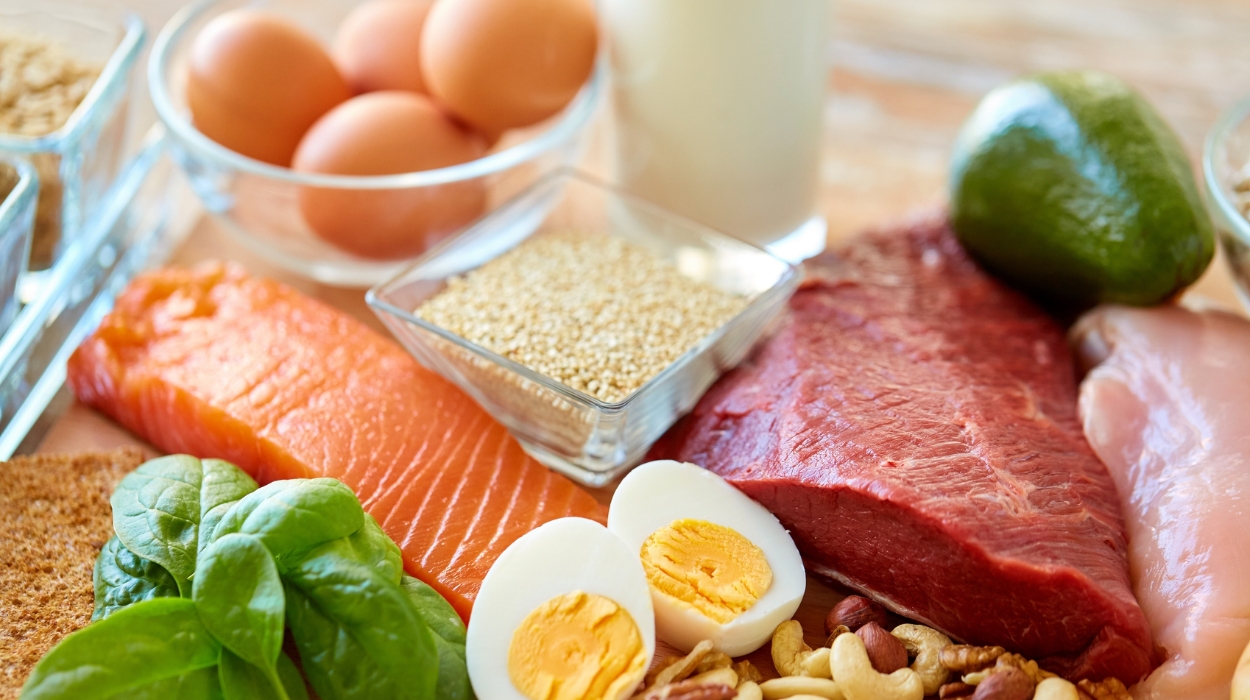
Protein serves many purposes in weight loss and fat loss. For starters, protein is the building block[3] for our body, including muscles, so it is hard to replace fat with muscle if you’re not eating enough protein.
Secondly, protein stabilizes blood sugar and increases satiety,[4] which means you’ll be less inclined to snack or eat excessively throughout the day. Keeping meals in reasonable portions and intervals will help with fat loss efforts.
Eat Less Processed Carbohydrates
Carbohydrates are necessary for energy,[5] especially when working out. However, the amount and type of carbohydrate can make a difference in whether or not your body will use it as energy or store it as fat.
Processed carbohydrates, such as white pasta and bread, along with sugary foods can add weight[6] and excess fat to the body, blocking health goals. Instead of processed carbs, opt for small, strategic portions of whole grains, such as quinoa, nuts and seeds, buckwheat, and oats, or bulk up on more vegetables. Many whole carbohydrates also have protein.
While generally speaking, a low-carb diet entails eating less than 100 grams of carbs per day. However, everyone’s needs are different, and the amount of carbs a day to lose weight will vary depending on your age, sex, and medical conditions. Follow this guide for how to calculate net carbs.
Similarly, the amount of calories needed to lose weight will vary from one person to another. Generally speaking, women should consume between 1200-1500 calories per day, and men should consume between 1500-1800. However, this is a general recommendation and should be modified to your body as needed.
Eat More Fiber
Fiber, like protein, increases satiety,[7] making it less likely that you’ll want to snack on unhealthy foods in between meals. Fiber provides numerous health benefits beyond satiety, such as reduced risk of disease[8] and improved digestion. Fiber[9] can be broken down into soluble and insoluble fiber, found in fruits, vegetables, nuts, seeds, legumes, oats, and barley.
Fiber helps keep bowels regular, a necessary aspect of weight loss. When bowels flow smoothly, waste and toxins are eliminated on a regular basis and are less likely to be stored in the body.
Drink Enough Water
Drinking enough water is necessary to help the body function at optimal levels so that it can work for your weight loss efforts[10] rather than against them. Water replenishes hydration, which is particularly important when doing strength training three times a week as well as cardio. Drinking water can also help curb appetite in between meals.
How much water should you drink to lose weight? While everyone’s water intake needs will vary slightly, aim for at least eight full cups of water every day.
Get Enough Sleep

Weight loss and fat loss can be difficult to achieve if you’re skipping out on sleep. Lack of sleep, even for one night, can have inhibiting effects on weight loss. Sleep deprivation has been associated with not only weight gain,[11] but obesity, as well.
Sleep regulates the activity of many hormones,[12] including ghrelin and leptin, which control feelings of hunger and fullness, respectively. Sleep deprivation can, therefore, disrupt our appetite, making us feel hungrier and less sensitive to fullness, even after we’ve eaten, which can then lead to excessive snacking.
Furthermore, it’s not unusual to crave sweets and carbs after a poor night’s sleep. Carbs have sugar, which provides energy, so when we lack energy from proper sleep, we tend to reach for it through bread, cookies, and muffins.
Reduce Stress
We can’t talk about how to remove arm fat without talking about stress reduction.[13] Cortisol, the stress hormone, can impact and disrupt[14] the production and functioning of other hormones, whose job it is to keep our body in homeostasis. In other words, stress interferes with the body’s ability to function at its highest level.
Excess stress can cause excess body fat, which often shows up as belly fat,[15] however, fat can develop anywhere in the body when the body is continuously producing too much cortisol. By all means, watch your diet and exercise regularly, but do not overlook the importance of stress management for fat loss.
Consider deep breathing, meditation, therapy, taking things off your to-do list, spending time with family, being outdoors in nature, taking more vacations, and journaling as methods for reducing stress.
Best Exercises For Losing Arm Fat
Strength Training Exercises
Strength training uses resistance to build muscle and burn fat in the process. This can be done with weights, resistance bands, or using your own body weight. Some preferred exercises for strength training include:
One-Arm Tricep Curls
The one-arm tricep curl is a fantastic isolation exercise that primarily targets the triceps, helping you sculpt and strengthen the back of your upper arms. By holding a dumbbell in one hand and extending your arm overhead, you engage the triceps to lift and lower the weight, promoting muscle growth and toning.
This exercise enhances the definition of your triceps, improves tricep strength, and balances muscle development between your arms. Incorporate the one-arm tricep curl into your upper body routine to add variety and target the triceps effectively.
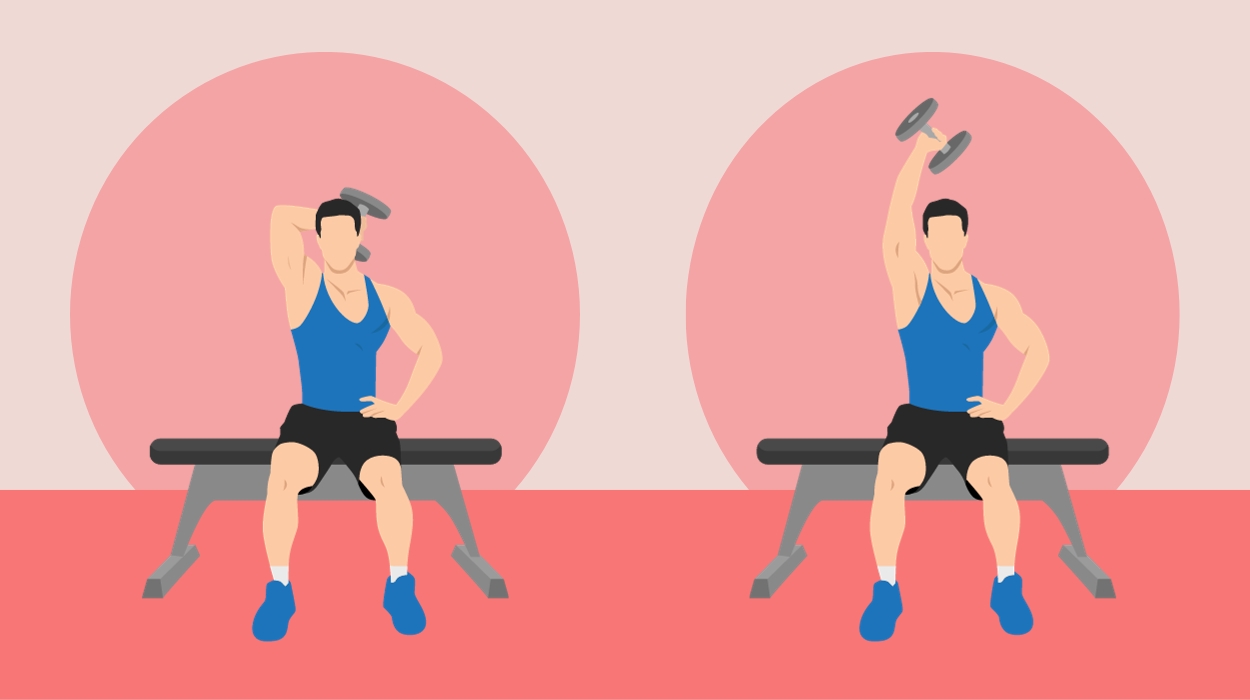
How To Do:
- Pick up a dumbbell over your head and bend your elbow so that the dumbbell is resting behind your head. The dumbbell should be level with the bottom of your neck.
- Extend your arm fully to push the dumbbell up over your head.
- Lower the dumbbell back down behind your neck slowly.
- Repeat multiple times then switch to the other arm.
Tips:
- Ensure your feet are firmly planted and your core engaged to provide a stable foundation while performing one-arm tricep curls.
- Avoid jerky movements to maximize muscle engagement and reduce the risk of injury.
- Gradually increase the weight to keep challenging your triceps and promoting muscle growth.
Optimal Sets & Reps: 3 sets of 10-12 reps.
Chair Dips
Chair dips are a highly effective bodyweight exercise that primarily targets the triceps, making it an excellent choice for building strength and definition in the back of your upper arms. This exercise involves lowering and lifting your body between two parallel surfaces, like chairs or parallel bars, using your triceps to power the movement.
Chair dips help tone and sculpt the triceps, improve functional upper body strength, and aid in activities that require pushing or lifting motions. Moreover, chair dips are an accessible and versatile exercise that can be done practically anywhere, making them an ideal addition to home workouts or when you don’t have access to a gym.
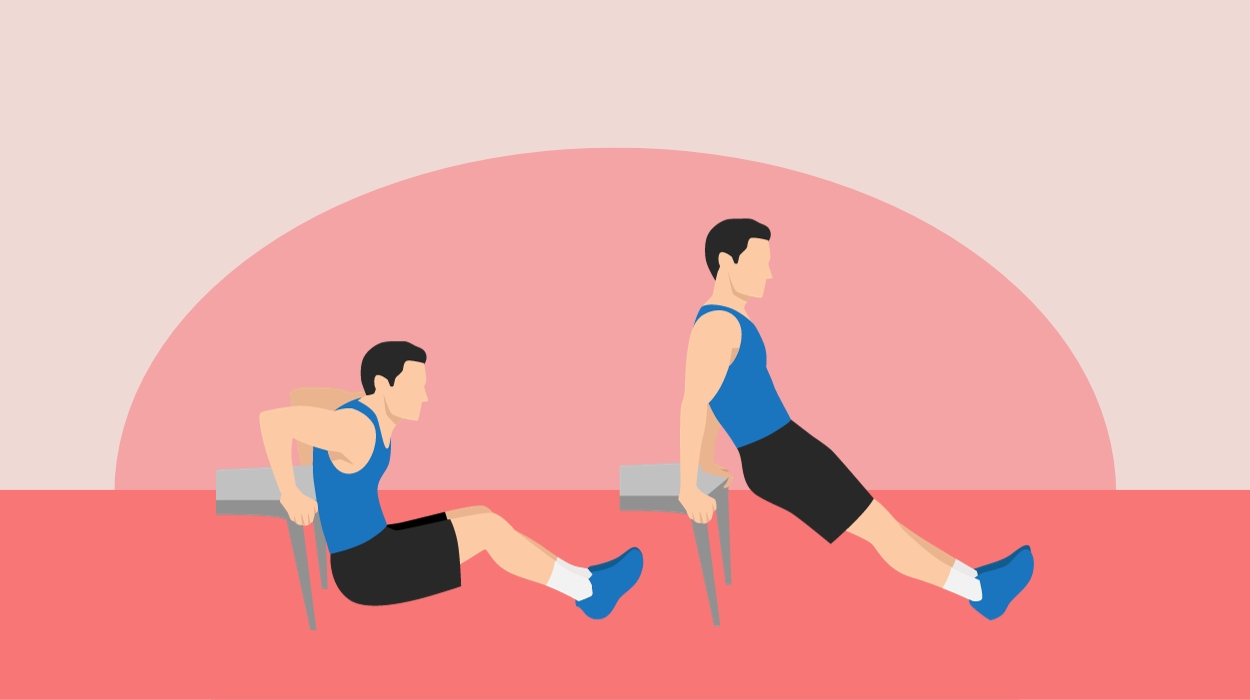
How To Do:
- Sit in a chair and rest your hands on the arms of the chair.
- Push yourself forward and off the chair and outstretch your legs.
- Bend your elbows to lower your body down toward the floor, without actually touching the floor, then push yourself up.
- Repeat multiple times.
Tips:
- Position your hands shoulder-width apart on the edge of the chair, fingers pointing forward to ensure stability and effective engagement of the triceps during chair dips.
- Avoid rapid movements to maximize muscle activation and minimize the risk of strain or injury.
- To make chair dips more challenging, extend your legs fully, or elevate your feet on another surface. To make them easier, keep your knees bent at a 90-degree angle.
Optimal Sets & Reps: 3 sets of 8-10 reps.
Diamond Push-Ups
Diamond push-ups, a variation of traditional push-ups, are an excellent exercise for targeting the triceps, chest, and shoulders. By placing your hands close together under your chest in a diamond shape, you intensify the engagement of your triceps during the movement.
This exercise helps develop strength and definition in the triceps, enhances chest and shoulder muscles, and provides an added benefit of core engagement. They can be adapted to different fitness levels and are a convenient bodyweight exercise you can do virtually anywhere.
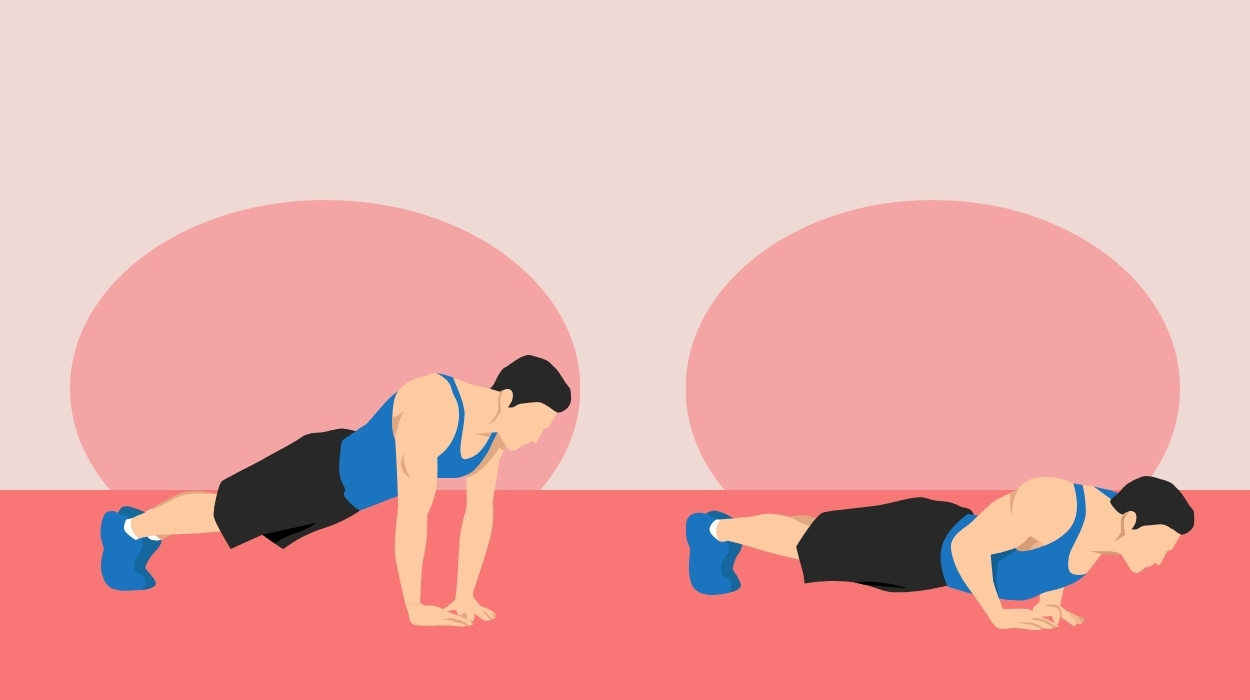
How To Do:
- In the push-up starting position, bring your hands together so that your fingers touch and make a diamond shape (your thumbs should touch each other and your forefingers should touch each other).
- Proceed to do push-ups with your arms in this position. This narrow version of a push-up targets arm muscles more precisely.
Tips:
- Ensure proper hand placement to target the triceps more intensely.
- Keep your body in a straight line from head to heels, engage your core, and lower yourself with control.
- Gradually increase the number of repetitions or sets to keep challenging your chest, shoulders, and triceps.
Optimal Sets & Reps: 3 sets of 10-12 reps
Counter Push-Ups
Counter push-ups are a beginner-friendly variation of traditional push-ups, designed to build upper body strength and improve overall fitness. This exercise primarily targets the chest, shoulders, and triceps while also engaging your core muscles for stability.
Counter push-ups are an excellent starting point for those new to exercise or looking for a lower-impact alternative to regular push-ups. They can be done using a sturdy countertop, table, or any elevated surface, making them accessible for all fitness levels. By incorporating counter push-ups into your fitness routine, you can gradually build strength, improve upper body aesthetics, and work towards more advanced variations as your fitness level progresses.
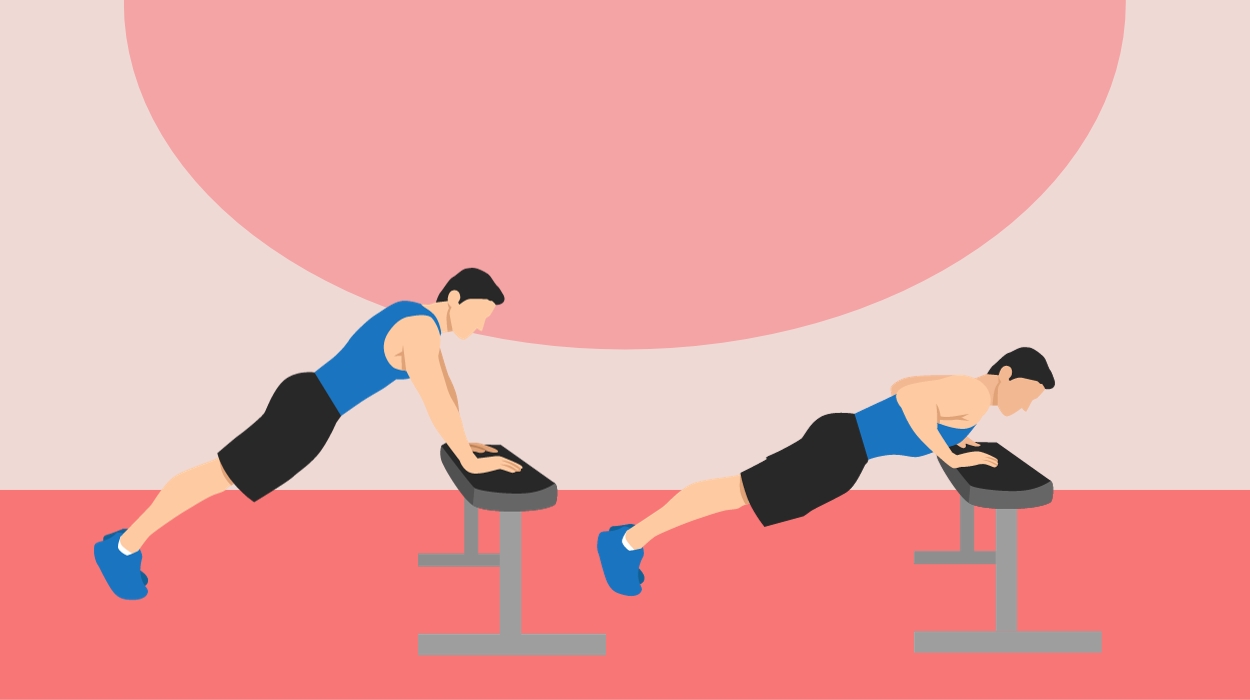
How To Do:
- Use a counter or steady table to lean your hands against. Keep your feet steady and your legs and arms straight.
- Proceed to do push-ups pushing off of the counter.
Tips:
- Ensure the countertop or surface you use for counter push-ups is stable and can support your body weight.
- Keep your body in a straight line from head to heels while performing counter push-ups.
- Gradually increase the number of repetitions or sets to continue challenging your upper body.
Optimal Sets & Reps: 3 sets of 10-12 reps.
Lateral Plank Walks
This is a dynamic and effective exercise for targeting the core, specifically the obliques, while also engaging the shoulders, chest, and hip muscles.
Lateral plank walks enhance core strength, helping to stabilize your spine and improve posture. By engaging the oblique muscles, this exercise can also aid in achieving a more defined waistline and overall core aesthetics. Additionally, lateral plank walks improve shoulder and hip stability, which can be particularly beneficial for athletes or anyone seeking to enhance their functional fitness.
How To Do:
- In a plank position, hold your core in and keep your legs straight and arms firm.
- Move your left arm and leg out to the left side, place them down, and then bring the right arm and leg over to meet them.
- Continue “walking” to the left for several steps, then repeat going in the other direction.
Tips:
- Keep your body in a straight line from head to heels.
- Move your hips and feet laterally with control and precision, ensuring each step is deliberate.
- Begin with a shorter distance and fewer repetitions, and gradually increase as you build strength and balance.
Optimal Sets & Reps: 3 sets of 8-10 reps.
Single-Arm Lateral Raises
Single-arm lateral raises are a fantastic exercise to isolate and strengthen the lateral deltoid muscles of the shoulders. By lifting one arm at a time, you create targeted tension in the shoulders, helping to enhance shoulder width and definition.
This exercise improves shoulder stability and mobility, reducing the risk of injury in daily activities or sports. It also helps correct muscle imbalances in the shoulders, leading to better posture and overall upper body strength. Single-arm lateral raises are also versatile and can be done with dumbbells or resistance bands, making them suitable for various fitness levels.
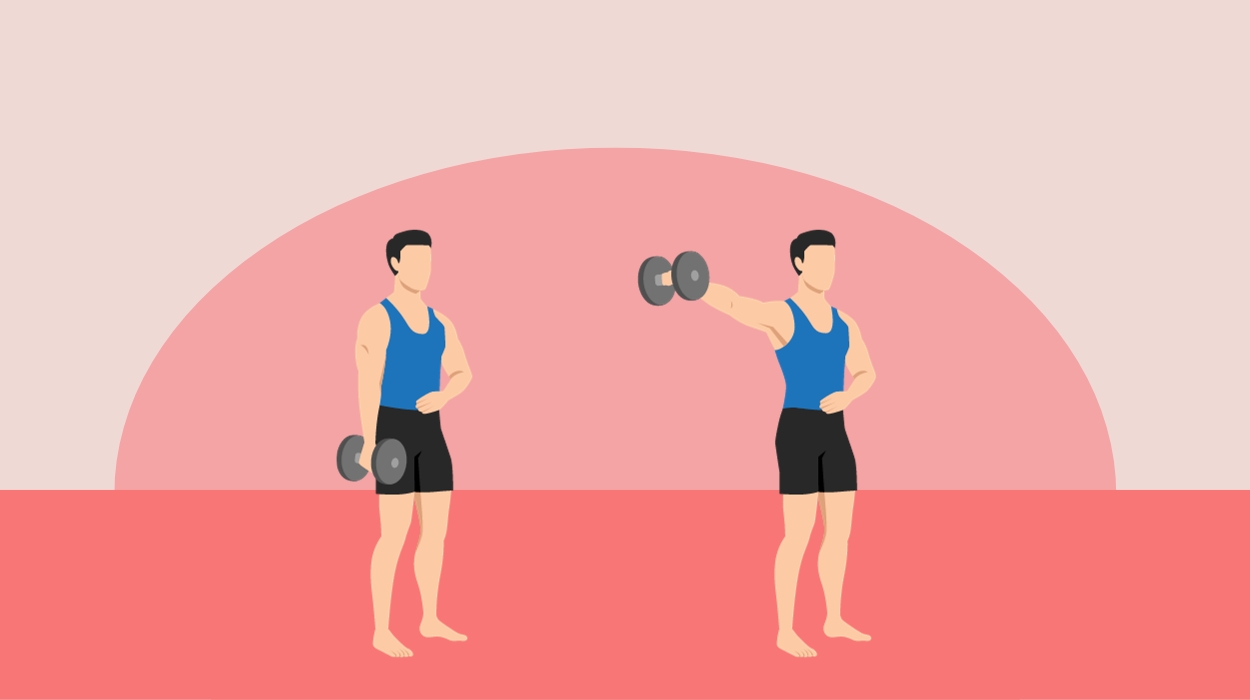
How To Do:
- Stand up straight and hold a dumbbell in one hand, keeping it at your side.
- With a straight arm, lift the dumbbell up so that your arm comes to a 90-degree angle with the floor.
- Lower your arm down, keeping your arm straight. Repeat multiple times, then switch to the other arm. The arm you are not using can be placed on your hip.
Tips:
- Stand with your feet shoulder-width apart, keep your back straight, and engage your core for good posture.
- Keep your core muscles tight to stabilize your body during the movement.
- Lower your arm slowly and with control to maximize the time under tension on your lateral deltoid.
Optimal Sets & Reps: 3 sets of 10-12 reps.
Cardio Exercises
Cardio is any activity that gets your heart rate up. High intensity is usually done for shorter periods of time. During this time, your heart is working at almost full capacity. By contrast, low intensity has a lower impact and heart rate, making it easier to engage in the exercise for longer. Examples of cardio include
- Biking.
- Running.
- Jogging.
- Walking.
- Sprinting.
- Hiking.
- Swimming.
- Rollerblading.
- Rowing.
- Dancing.
- Jumping rope.
- Boxing.
- Trampolining.
- Playing a sport.
- Hula-hooping.
- Rock climbing.
- Climbing stairs.
Other Tips To Lose Arm Fat Fast
Joining a fitness or weight loss group can be extremely beneficial for helping you reach your goals. By joining a group, you get mentoring, support, and accountability. You can share and learn from others, which can increase your chances of success.
When all aspects of a healthy lifestyle have been addressed–diet, exercise, sleep, hydration, stress–and you’ve joined a support group, but you find you need additional tools to lose arm fat, consider surgery.
A surgeon can remove fat from the arms (liposuction) or perform a Brachioplasty, also referred to as an arm lift. This method is the most invasive and expensive of all options. It also poses risks which should be discussed with the surgeon ahead of time.
Conclusion
Losing arm fat is attainable, and it can be done in two weeks when proper attention is paid to diet and lifestyle. In particular, a healthy, balanced diet high in fiber, protein, and nutrients, and low in processed carbohydrates can help you achieve fat loss, especially when combined with a workout routine consisting of resistance training and cardio.
Exercise every day, alternating cardio with resistance training. When doing resistance training, choose exercises that target the arms, such as tricep curls, planks, and push-ups. However, even with the best diet and exercise routine, fat loss can be hindered by stress, sleep deprivation, and dehydration, so pay attention to these aspects of lifestyle as well.
Frequently Asked Questions
Lifting weights is one of the best ways to burn the most arm fat, and replace it with muscle mass.
Poor diet and lack of exercise are the most common causes of arm fat accumulation. Other factors include not sleeping well, being poorly hydrated, and even genetics, as some individuals are predisposed to more body fat.
Yes, it can. Arm fat is only permanent if you don’t address it. However, if you regularly exercise, using a combination of strength training exercises and cardio, and watch your diet, some (if not most) of the fat can be lost.
Upper arm muscles are smaller than other body muscles, which makes them harder to tone. This can allow fat to remain in the area instead of muscle mass.
Reduce calories, especially from processed foods, engage in cardio and strength training exercises, eat more protein and fiber, manage your stress, and get enough sleep and water. In the meantime, you can wear long sleeves to make flabby arms look thinner.
Yes. Just as overall weight gain can increase fat in the arms, overall weight loss can help reduce fat in the arms.
Strength training can be more targeted to the arms, making it slightly more impactful than cardio, however, cardio is part of the fat loss equation and should not be skipped.
No. Many strength training exercises use your own body weight. Additionally, many cardio exercises, such as running and dancing, can be done without equipment.
 Expert's opinion
Expert's opinion
